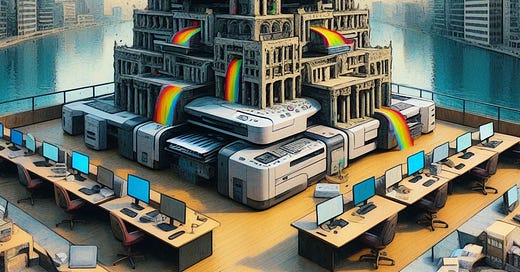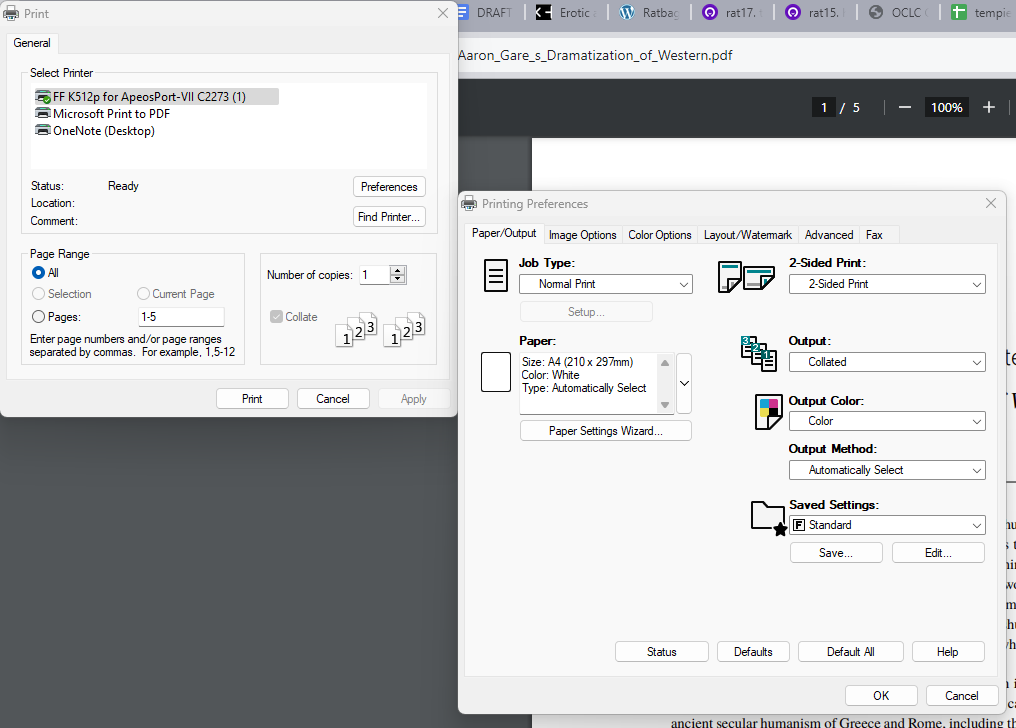Communications: opacity and the finicky printer
printery examples, the... ---gap as interdisciplinary lead
There has been a call for greater clarity or precision in writing. At least that is what I am taking away, at first, from what they have written:
Notice: it is actually hard to ever make use of anyone else’s thinking on anything. As a professor I can tell you that the most painful part of my job is reading student essays. Even though students are trying hard to make themselves understood by a person who they’ve been listening carefully to for an entire semester, and on a topic chosen to make this communication easier, even so it is usually quite a struggle to dimly understand the median student essay.
[…]
So this is a plausible explanation for much human disagreement: while we can just simply put weight on others’ opinions re our decisions that are close enough to those opinions, we just don’t know how to update our mental systems to take their opaque opinions into account more generally. Our minds aren’t set up to take those as standard inputs. It is just too hard to search in the space of all possible ways their minds could have come to such conclusions. While we can and do take their opinions as hints re what arguments and evidence to seek and consider, we find it hard to integrate their mere opinions deeply into our thinking.
We might want to agree, and can do so awkwardly in particular cases, but we can’t flexibly and fluidly integrate opinions with opaque sources into our thoughts.
From:
The desire, or need, or urge… —to communicate /\#**!#\/ is actively interfering in communication.
Even as we/they develop group conformities, the effort begins to act as an immunity… —peeps are using conventions that hinder cross-discipline comms. There are so many of “them” too:- cant, jargon, specialist terminology, even when they are not actively used as shibboleths to divide and cause chaos. Too many definitions may not help with clarity.
It reminds me of trying to print something out on a printer and never getting the result one intended. This is because each printer maker has different “expectations” even when using standard inputs, and which then have to run on various operating systems and be backwards compatible with a ye olde variety of operating systems and connectivity (wireless, network, USB) and the umpteen applications that might use them and implement things in their own way, in defiance of a OS or in supplication to an OS. As there is no money in manufacturers co-operating on a common standard description or terminology (some bits are inherited from printing trades of various regions, some bits are not) for their defaults. It is still a mess, decades after the first laser printer appeared (late 1970s, saw my first in the early 1980s).
The thing is that the mess is the result of things that are logical, or even mechanical. As series of choices and options that lead into, but not out of, a labyrinth of rationally created possibilities. And you cannot get what you want. Sort of a formalism of choices, a computational space that defies your intuitions, your wants, your desire to print and thus communicate.
Intellectual disciplines and trade jargon are like the world of printers. Manufacturers, OS devs and application makers all try to talk to each other in their own way. They want to sell you something, but they have no way to really get feedback even when they try to communicate and create a better way to do it (again). In diverse communities this is when fascist leaders make their call, and make it all much much worse.
While this silliness can be encouraged by economic and social forces to not work together, such that all their consumers end up subsidizing the bad work as the market satisficing its arse onwards into the future never moving away from the mediocrity of middle managers muddling there way through to retirement or the next side hustle.
To print a journal article as a booklet one can fold on a recent Windows 11 and a particular printer, in order to do this the simplest imposition: it takes 8+ steps of clicking through three layers of printer “settings” : Application/Windows 11, then the ye olde “System Settings” tick box, which has a “preferences” button which actually leads to the printer manufacturer’s interface which is huge, by which time one is lost and does not understand how each layer affects/controls the other layers. They are all doing the same thing, ever so differently, but how to get all the ducks in a row?
It’s all logical, so why is it so hard?
If we reduce it to only 5 binary choices, (the above example has hundreds o (permutations) a random choice will give the desired outcome less than 10% of the time. And generally, if on is not trying to be random, actually trying to work it out, the desired result is less than that.
What Robin Hanson is highlighting in Opacity Blocks Communication, is that even when we seek to reach out, we can remain trapped in our idiolects (personal or gang-related), and even when we see analogies across intellectual endeavours. Even when we are learning with-in a trade (when young I found recipe jargon terrifying, and people wonder why some peeps don’t cook). Even. Odd.
I.E. specialised language communicates effectively or efficiently to its audience, who may wish to share it, in order to see growth in that audience. But, if there is some commercial or livelihood want, or just intellectual perversity. Then these guilds can survive with a competitive advantage in holding and maintaining secrets which are passed on to the select few. And the rest of us can go screw ourselves. Some markets do it worse, some worserer.
Standards agreed and conventions used by custom or habit, are one way to reduce the opacity of communication, however opacity is also produced by the success of jargon in their own fields/business segments/markets/{fucking printer guilds of stupidity}.
Its worth highlighting printery because one cannot print out (even in this day and age) what one can see in one’ mind’s eye, without a process of trial and error, many times, and then sticking to that routine (woe is the system upgrade, that will stuff it up) because of the mechanical logic employed in designing the interfaces.
One can understand the call for clarity. But this mess is also the result of clarity. By each manufacturer and developer, each endeavour. Each success builds a new tower.
Opacity can be the result of clarity, even if it is by middle managers muddling there way to a disynergy of mediocrity, in order to satisfice their arse-saving careers.
A study of the… —gap might be the best way forward for inter-disciplinary work.
But how does one explain that?









